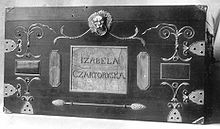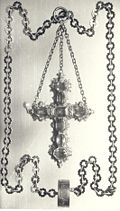
Royal Casket
Encyclopedia

Temple of the Sibyl
The Temple of the Sibyl is a colonnaded round monopteral temple-like structure at Puławy, Poland, built in the late 18th century as a museum by Izabela Czartoryska.-History:...
at Puławy.
Contents
The relics contained in the casket included:
- Portrait of Queen Constance of AustriaConstance of AustriaArchduchess Constance of Austria was a Queen consort of Poland.-Biography:...
in a silver dress made by King Sigismund III VasaSigismund III VasaSigismund III Vasa was King of Poland and Grand Duke of Lithuania, a monarch of the united Polish–Lithuanian Commonwealth from 1587 to 1632, and King of Sweden from 1592 until he was deposed in 1599...
, - Silver rosary of Queen Marie Leszczyńska,
- Ivory box in a silver gilded frame of King John III SobieskiJohn III SobieskiJohn III Sobieski was one of the most notable monarchs of the Polish–Lithuanian Commonwealth, from 1674 until his death King of Poland and Grand Duke of Lithuania. Sobieski's 22-year-reign was marked by a period of the Commonwealth's stabilization, much needed after the turmoil of the Deluge and...
, - Gold watch of Queen Marie CasimireMarie Casimire Louise de la Grange d'ArquienMarie Casimire Louise de La Grange d'Arquien, in Polish: Maria Kazimiera, known also by the diminutive form "Marysieńka" was consort to King John III Sobieski, from 1674 to 1696.-Biography:...
, - Gold snuff-box decorated with diamonds and an enamel miniature of King Stanisław August Poniatowski,
- Gold watch of King Augustus IIAugustus II the StrongFrederick Augustus I or Augustus II the Strong was Elector of Saxony and King of Poland and Grand Duke of Lithuania ....
, - Gold enameled chain of King John II Casimir,
- Pectoral cross of King Sigismund the OldSigismund I the OldSigismund I of Poland , of the Jagiellon dynasty, reigned as King of Poland and also as the Grand Duke of Lithuania from 1506 until 1548...
, made of red jasper in a gold frame with a gold chain, - Silver filigree cutlery of Prince Zygmunt Kazimierz,
- Crystal watch in a gold frame of King Sigismund III VasaSigismund III VasaSigismund III Vasa was King of Poland and Grand Duke of Lithuania, a monarch of the united Polish–Lithuanian Commonwealth from 1587 to 1632, and King of Sweden from 1592 until he was deposed in 1599...
, - Gold watch of King Stanisław Leszczyński,
- Gold enameled pendant with "A" monogram and a gold chain of Anna Jagiellon,
- Gold filigree chain of Queen Ludwika Maria GonzagaLudwika Maria GonzagaMarie Louise Gonzaga was queen consort to two Polish kings: Władysław IV Vasa, and John II Casimir Vasa...
etc.
The casket survived all the confiscations after the collapses of the Polish national uprisings, because it had been moved to Kraków
Kraków
Kraków also Krakow, or Cracow , is the second largest and one of the oldest cities in Poland. Situated on the Vistula River in the Lesser Poland region, the city dates back to the 7th century. Kraków has traditionally been one of the leading centres of Polish academic, cultural, and artistic life...
.
When World War II
World War II
World War II, or the Second World War , was a global conflict lasting from 1939 to 1945, involving most of the world's nations—including all of the great powers—eventually forming two opposing military alliances: the Allies and the Axis...
broke out, it was transported together with the rich collection of the Czartoryski Museum
Czartoryski Museum
The Czartoryski Museum and Library is a museum located in Kraków, Poland, founded in Puławy in 1796 by Princess Izabela Czartoryska. The Puławy collections were partly destroyed after the November uprising of 1830–1831 and the subsequent confiscation of the Czartoryskis' property by the Russians...
to Sieniawa
Sieniawa
Sieniawa is a town in southeastern Poland. It had a population of 2,127 inhabitants . Since 1999, Sieniawa has been part of Subcarpathian Province.-References:Notes...
and hidden in a repository, in a palace outbuilding, which was later bricked up. However, the German owner of a mill who worked for the Czartoryski family betrayed the hiding place to Wehrmacht
Wehrmacht
The Wehrmacht – from , to defend and , the might/power) were the unified armed forces of Nazi Germany from 1935 to 1945. It consisted of the Heer , the Kriegsmarine and the Luftwaffe .-Origin and use of the term:...
soldiers, who entered Sieniawa
Sieniawa
Sieniawa is a town in southeastern Poland. It had a population of 2,127 inhabitants . Since 1999, Sieniawa has been part of Subcarpathian Province.-References:Notes...
on 14 September 1939. The soldiers broke into the palace and plundered the collection. They robbed the Royal Casket and distributed its contents among themselves. All the precious items were probably destroyed.
See also
- Polish Crown JewelsPolish Crown JewelsThe only surviving original piece of the Polish Crown Jewels from the time of the Piast dynasty is the ceremonial sword - Szczerbiec. It is currently on display along with other preserved royal items in the Wawel Royal Castle Museum, Kraków....
- Czartoryski MuseumCzartoryski MuseumThe Czartoryski Museum and Library is a museum located in Kraków, Poland, founded in Puławy in 1796 by Princess Izabela Czartoryska. The Puławy collections were partly destroyed after the November uprising of 1830–1831 and the subsequent confiscation of the Czartoryskis' property by the Russians...
- Polish culture during World War IIPolish culture during World War IIPolish culture during World War II was suppressed by the occupying powers of Nazi Germany and the Soviet Union, both of whom were hostile to Poland's people and cultural heritage. Policies aimed at cultural genocide resulted in the deaths of thousands of scholars and artists, and the theft and...
- Nazi plunderNazi plunderNazi plunder refers to art theft and other items stolen as a result of the organized looting of European countries during the time of the Third Reich by agents acting on behalf of the ruling Nazi Party of Germany. Plundering occurred from 1933 until the end of World War II, particularly by military...

